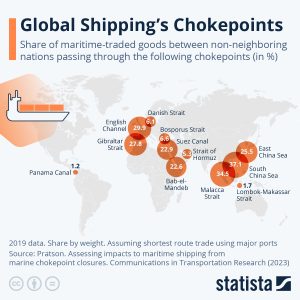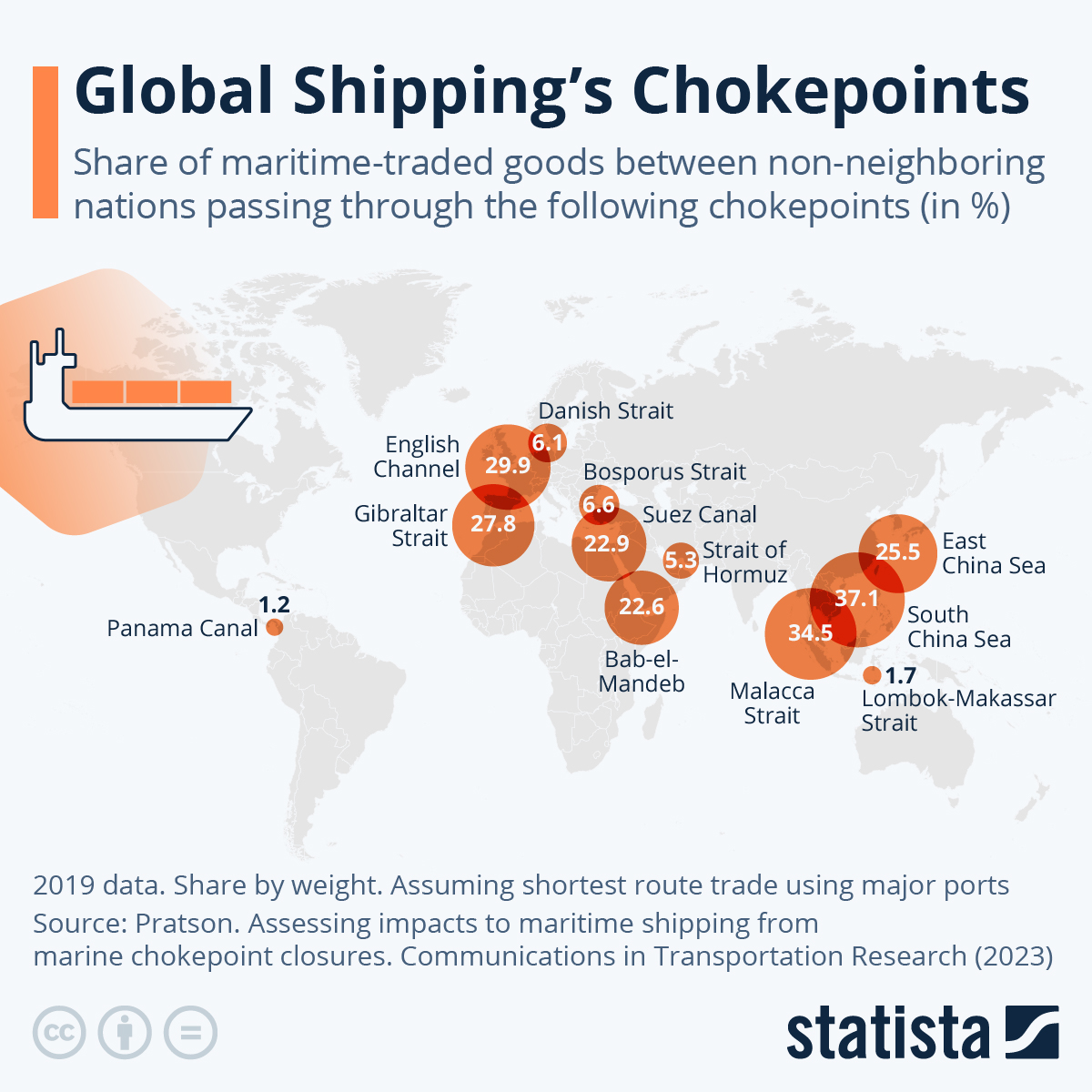Maritime trade routes are the backbone of the global economy, but they rely on a handful of critical chokepoints—narrow passages where congestion, geopolitical tensions, or natural disasters can disrupt supply chains worldwide. These strategic waterways handle trillions in trade annually, making them both vital and vulnerable.

Image credit: https://www.statista.com/chart/31489/shippings-chokepoints/
With more and more shipping companies extending full or partial closures of Red Sea shipping routes due to attacks by Yemeni rebels, global trade could be seriously affected. According to a new analysis based on 2019 data published in academic journal Communications in Transportation Research, 22-23 percent of maritime-traded goods between non-neighboring countries pass through the Red Sea, more specifically its chokepoints Bab-el-Mandeb and the Suez Canal. Other estimates even put the share of seaborne cargo passing through the area as high as 30 percent.
The passage is also an important chokepoint for oil shipments – not as significant as the Strait of Hormuz or the Strait of Malacca – but still important. As a result of the situation, the global oil price has already shown volatility. The Red Sea is also an important transit point for global food and fertilizer shipments, a type of commodity trade already thrown into disarray by the war in Ukraine as well as subsequent blockades of Black Sea shipping routes. According to Chatham House, Bab-el-Mandeb saw the transit of almost 20 percent of global rice and almost 15 percent of global wheat exports previous to the pandemic and the Ukraine crisis. It is also important for fertilizer shipments. The biggest chokepoints of global trade (by weight) are centered around China due to the country’s export prowess. An estimated 80 percent of goods traded globally are transported via sea routes. Calculating by value instead of weight, this number is still 70 percent.
Key Global Shipping Chokepoints
1. Strait of Hormuz (Middle East)
-
Why it matters:
-
20-30% of global oil shipments pass through (EIA)
-
Connects Persian Gulf producers (Saudi Arabia, UAE, Iran) to world markets
-
-
Risks:
-
Geopolitical tensions (Iran-US conflicts, tanker seizures)
-
Potential blockade could spike oil prices globally
-
2. Suez Canal (Egypt)
-
Why it matters:
-
12% of world trade, including 30% of global container traffic
-
Shortcut between Europe & Asia (saves 2 weeks vs. Africa’s Cape route)
-
-
Risks:
-
2021 Ever Given blockage cost $10B per day in delayed trade
-
Political instability in Egypt
-
3. Strait of Malacca (Southeast Asia)
-
Why it matters:
-
25% of global maritime trade, including 80% of China’s oil imports
-
Connects Indian & Pacific Oceans (China, India, Japan rely on it)
-
-
Risks:
-
Piracy, territorial disputes
-
Overcapacity—traffic jams threaten delays
-
4. Panama Canal (Central America)
-
Why it matters:
-
5% of world trade, critical for US-East Asia routes
-
Saves 8,000 miles vs. sailing around South America
-
-
Risks:
-
Droughts (2023-24 water shortages reduced ship crossings by 36%)
-
Competition from Arctic routes as ice melts
-
5. Bab el-Mandeb (Red Sea / Yemen)
-
Why it matters:
-
10% of global oil & 20% of container ships transit here
-
Gateway to Suez Canal
-
-
Risks:
-
attacks (2023-24) forced reroutes, spiking shipping costs
-
–
Why Are Chokepoints So Dangerous for Global Trade?
-
Single point of failure – A closure can halt billions in commerce daily
-
Supply chain delays → Inflation (e.g., 2021 Suez blockage raised consumer prices)
-
Geopolitical leverage – Controlling a chokepoint = economic weapon (e.g., Iran’s Hormuz threats)
–
Are There Alternatives?
Some workarounds exist, but none are perfect:
-
Arctic routes (melting ice opens new paths, but still risky)
-
Land bridges (rail from China to Europe, but limited capacity)
-
Diversified supply chains (e.g., Vietnam/India manufacturing vs. China)
Yet, no substitute matches the cost and scale of maritime chokepoints.

